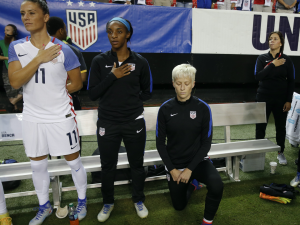New study and data interactive present differences in socioeconomic and health indicators among six racial groups of LGBT adults
LOS ANGELES – A new study by the Williams Institute at UCLA School of Law finds that LGBTQ+ people of color fared worse than White LGBTQ+ people in most measures of health and economic well-being. For instance, an estimated 47% of LGBTQ+ people of color live in a low-income household, compared to 36% of White LGBTQ+ adults.
This report is the final installment in the series LGBT Well-Being at the Intersection of Race that uses data from Gallup and the Generations and Transpop studies to assess whether adult LGBTQ+ people of color differ from White LGBTQ+ people in several areas of health and socioeconomic well-being. The data, collected from surveys conducted between 2012-2018, reflect enduring patterns of disparities along the lines of race, gender, and sexuality observed in other studies before and since the start of the COVID-19 pandemic.
Results show that racial disparities among LGBTQ+ adults exist within many areas, but not all. Fewer adult LGBTQ+ people of color (31%) report receiving a depression diagnosis compared to White LGBTQ+ people (37%). White LGBTQ+ women (44%) are the most likely to have depression.
The study also found significant differences in well-being among people of color. For instance, Latinx and Asian American LGBTQ+ people reported lower levels of unemployment than other groups, and Alaskan Native LGBTQ+ adults have among the highest rates of being uninsured.
“The relationship between race and LGBTQ+ status is a complicated one that differs by outcome and racial group,” said lead author Bianca D.M. Wilson, Senior Scholar of Public Policy at the Williams Institute. “Social and policy interventions that address economic and health disparities need to examine their impact on racial, gender and LGBTQ+ populations, both separately and at their intersection.”
KEY FINDINGS
Demographic characteristics
- More adult LGBTQ+ people of color are under 34 years old (62% vs 45%), live in urban areas (90% vs 85%), and are single (66% vs 56%) than White LGBTQ+ people.
- Fewer LGBTQ+ people of color have a college degree (25% vs 43%), and more are raising children (40% vs 22%) than White LGBTQ+ people.
Economic characteristics
- Nearly half (47%) of LGBT people of color live in a low-income household compared to 36% of White LGBTQ+ adults.
- More than half (51%) of LGBTQ+ women of color live in low-income households, compared to 43% of White LGBTQ+ women.
- 12% of LGBTQ+ people of color are unemployed, compared to 9% of White LGBTQ+ people.
- About one-third (34%) of LGBTQ+ people of color face food insecurity, compared to 22% of White LGBTQ+ people.
Mental and Physical Health
- More than one-quarter (27%) of LGBTQ+ people of color report fair or poor health, compared to 22% of White LGBTQ+ people.
- 31% of LGBTQ+ people of color have received a diagnosis of depression, compared to 37% of White LGBTQ+ people.
- White LGBTQ+ women are more likely to have depression than LGBTQ+ women of color (44% vs 36%).
The Williams Institute’s new data interactive, Race and Well-Being Among LGBTQ+ Adults, provides a summary of key measures of socioeconomic and well-being across six racial and ethnic groups, as well as an overall estimate for people of color.




